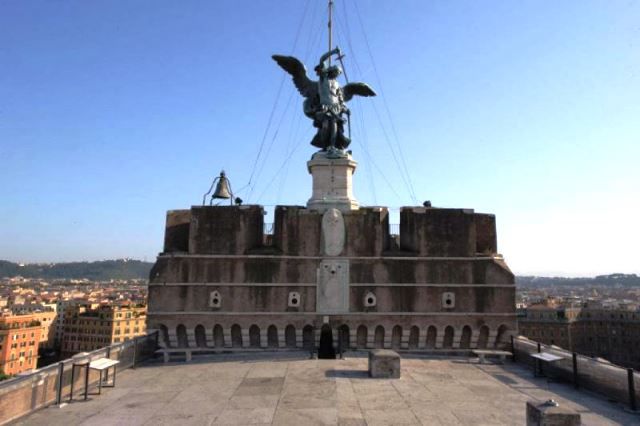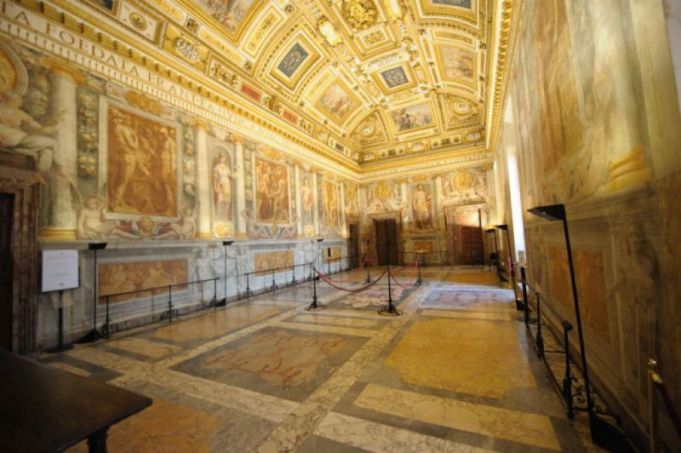If you want to get a true sense of Rome’s history and its many transformations since its birth, Castel S. Angelo is a fascinating place to start.
This circular construction surrounded by a rectangular structure has followed the story of Rome and experienced its own metamorphosis over the centuries. The story of Rome seems to echo through its cavernous hallways, telling tales of the city’s victories and sackings, as well as its popes, painters and prisoners.
Originally built as a tomb for Emperor Hadrian and his family in 123 AD, Castel S. Angelo later became a stronghold within the Aurelian walls, a bastion to protect the glorious city of Rome.
The secret passageway

In 1277, a secret passageway known as the Passetto di Borgo connected the castle to the Vatican. This enabled popes to escape when the city was under siege. For example, when Rome was being sacked in 1527, nearly the entire battalion of Swiss Guards was massacred, but Pope Clement VII made his escape through the secret passageway to the sanctity of Castel S. Angelo.
Also Read:
- Best day trips from Rome
- 29 Best Things To Do in Rome
- Top 10 beaches near Rome
- Visiting the Roman Forum
- How to visit Galleria Borghese in Rome
- How to buy tickets for the Vatican Museum
- Hadrian's Villa in Tivoli
- Visiting the Vatican Museums: All You Need to Know
Other popes through the ages took refuge in the castle walls, which provided a very comfortable retreat, evidenced by the splendour of the papal apartments. In fact, Raphael himself decorated one of the lavish bedrooms inside the castle. But as well as finding a warm welcome in its walls, the same popes might also have found themselves being imprisoned in the same building.
Beneath the bedrooms remain the prison and torture chamber – an eerie reminder of the castle’s darker past. The small square inside the castle even staged executions ordered by the papal states.
Although these walls have heard the screams of prisoners and seen the blood of soldiers, there is also beauty and tranquillity to be found in Castel S. Angelo, such as its troves of treasures and artworks, including Renaissance decorative paintings. It has even been transformed into a movie set, as the location for Dan Brown’s Angels and Demons and in the backdrop of Roman Holiday starring Audrey Hepburn.
The Terrace

And visitors can experience the beauty of Rome itself from the gorgeous terrace on the roof of the castle, with dinners hosted during the summer months and panoramic views of the Eternal City. Opera fans will most likely recognise this grand terrace, as well as its angel, from Act III of Puccini’s Tosca. It is here that the opera’s heroine, throws herself off the battlements after the death of her lover to escape being captured by her enemies.
The Angel

At the top of the castle stands an angel, seemingly guarding the structure and the city’s inhabitants beneath. This is the Archangel Michael, sheathing his sword and ending the city’s terrible plague at the end of the sixth century. The story goes that Pope Gregory the Great held a procession through the streets to pray for the end of the plague. Looking up at the old mausoleum, Pope Gregory had a vision of an angel with its wings outspread and brandishing a sword, on the roof of Hadrian’s tomb. As he watched, the angel returned the sword to its sheath, which Pope Gregory understood to be a sign the plague was over. Hence the castle’s name, translated as Castle of the Holy Angel, and the bronze wings of its angelic statue (a replica of the original marble version) punctuating the Roman skyline as a sign of God’s mercy.
Perhaps due to its constant repurposing, the castle remains intact and seemingly impregnable, unlike so many of Rome’s great buildings, although its appearance and layout have shifted over the centuries to accommodate new structures. Today it exists as a complicated maze of corridors, rooms, vaults, staircases and courtyards.
The Museum

In 1925 the castle’s main function became that of a museum, with daily tours to see the treasures still held there and to get a sense of the ghosts of history that walk along its corridors. Located right on the river Tiber near the Vatican and St Peter’s Basilica, Castel S. Angelo is only a few minutes’ walk from Piazza Navona. The best route to the castle is by crossing Ponte S. Angelo (the Bridge of the Angels) from the historic centre. Outside, street performers and artists entertain the throngs of tourists coming to visit the castle or to take selfies in the shadows of its circular walls.
General Info
Castel Sant’Angelo is open to visitors Tuesday to Sunday, from 09.00-19.30, with later hours during the summer months.
Tickets:
Adults: €14
EU citizens (aged 18 – 24): €7
General Info
View on Map
Visiting Castel Sant’Angelo, Rome's Castle
Lungotevere Castello, 50, 00193 Roma RM, Italy




















